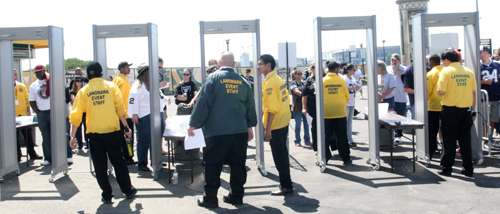An increase in game-day staffing and a summer of communication with fans and local media helped NFL teams navigate a fairly smooth transition to comply with the league’s new security process.
The league last November purchased and distributed 100 wand-style Garrett metal detectors to each NFL stadium. Within six weeks, nearly every stadium had them operating at more than half of their respective entrances. But this season the NFL requires that all fans be wanded prior to going through the turnstile at a game.
The blanket contract with Garrett allowed clubs to get a preferred rate if they chose to buy additional wands on their own. The Tampa Bay Buccaneers were one of many clubs that did so this season, and incurred additional costs to add and train staff.
 |
The Raiders installed walk-through magnetometers.
Photo by: Oakland Raiders |
Mickey Farrell, director of stadium operations at the Tampa Sports Authority, the public entity that runs Raymond James Stadium, said that because game-day security staff was increased by one-third, there has been no increase in the amount of time it takes to get fans through the gates.
Farrell said that total wanding costs for a sellout are projected to be approximately $25,000 per game, compared with $10,000 per game for pat-down costs. The team also was required to cover the costs of some additional wayfinding signage and barricades.
Several clubs said scanning takes 12-16 seconds on average, or approximately 30 percent longer than a standard
pat-down. Teams worked with local media to get the word out, and after a couple home games, fans across the board are arriving earlier.
At Oakland’s O.co Coliseum this summer, 110 permanent walk-through magnetometers were installed at a cost of approximately $340,000, making the stadium the first U.S. sports venue to have such technology at every entrance.
Raiders CEO Amy Trask said the team did an all-out blitz to remind its fans that the 46-year-old facility has fewer and narrower entry points than most NFL stadiums, and the new mandate could create bottlenecks.
“In encouraging our fans to arrive early, we asked them to imagine arriving at the airport to catch a plane — a plane with a capacity of 64,000 passengers — and to imagine all 64,000 arriving in the security and screening line at the same time,” Trask said. “We told them ‘That’s what’s going to happen at a stadium if 64,000 fans all try to enter in one fell swoop.’”
The Raiders used social media, direct mail, email and TV and radio announcements during preseason games to encourage fans to arrive early. The team’s “Early In and You May Win” program gave fans who went through the turnstiles an hour before kickoff chances to win prizes such as field passes, locker room tours, merchandise and gift cards. Raiderville, the pregame hospitality area outside the gates, now closes one hour prior to kickoff, rather than 15-20 minutes as in the past.
Trask said approximately 90 percent of the fans are now coming in well before kickoff.
At the league level, the NFL recently finished collecting all documentation that is necessary to apply for an extension of its Safety Act protection, and have turned over the data to league attorneys, who will ultimately submit the application to the U.S. Department of Homeland Security.
The NFL in December 2008 became the first — and still the only — league to be awarded a federal Safety Act designation from DHS. Officially known as the Support Anti-terrorism by Fostering Effective Technologies Act, the Act promotes the creation, deployment and use of antiterrorism technologies and practices. It was enacted in 2002 in response to the multibillion-dollar lawsuits filed after the Sept. 11, 2001, attacks. In receiving the designation, the NFL was granted protection for five years from having to pay claims that might be filed by victims against the league in the event of a terrorist attack at one of its games.
Ray DiNunzio, the league’s director of strategic security, said the new application will be several times thicker than the original nine-page document because the league now is obligated to show DHS how security practices are being implemented, and that the enforcement and compliance with them is in place. The documentation comes from things such as annual league-led unannounced inspections of each of the 31 stadiums. Proof of level of liability coverage, and pending stadium-related lawsuits also must be included.
“We’ve certainly advanced since our application in 2008,” DiNunzio said. “The concern after 9/11 has been suicide bombers. Since then we’ve had ‘limited pat-downs,’ but those were just that: limited. The threat since then has evolved to active shooters.”
The league’s Safety Act certification and designation expires in December 2013, and DiNunzio said several factors are affecting the league’s decision about whether to file early. Next month’s presidential election, for example, could bring about a change in the leadership at DHS, and there also is uncertainty about whether an early application would reset the league’s current five-year protection. DHS requires applicants to submit their data six months before expiration.
Another question is how the timing of the application, or a terrorist act on U.S. soil in the interim, would affect the league’s insurance costs. The league saw a decrease in its liability costs after the 2008 award.
“That was part of the focus point in getting certified,” DiNunzio said. “The whole point of the designation from the NFL perspective is to limit the liability in the event of a terrorist act.”




